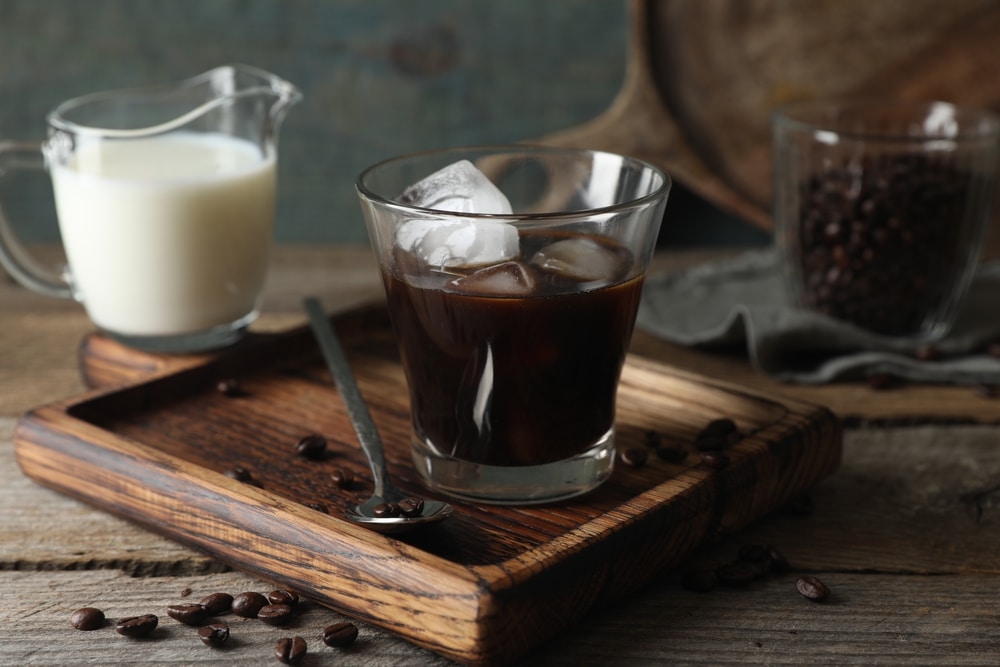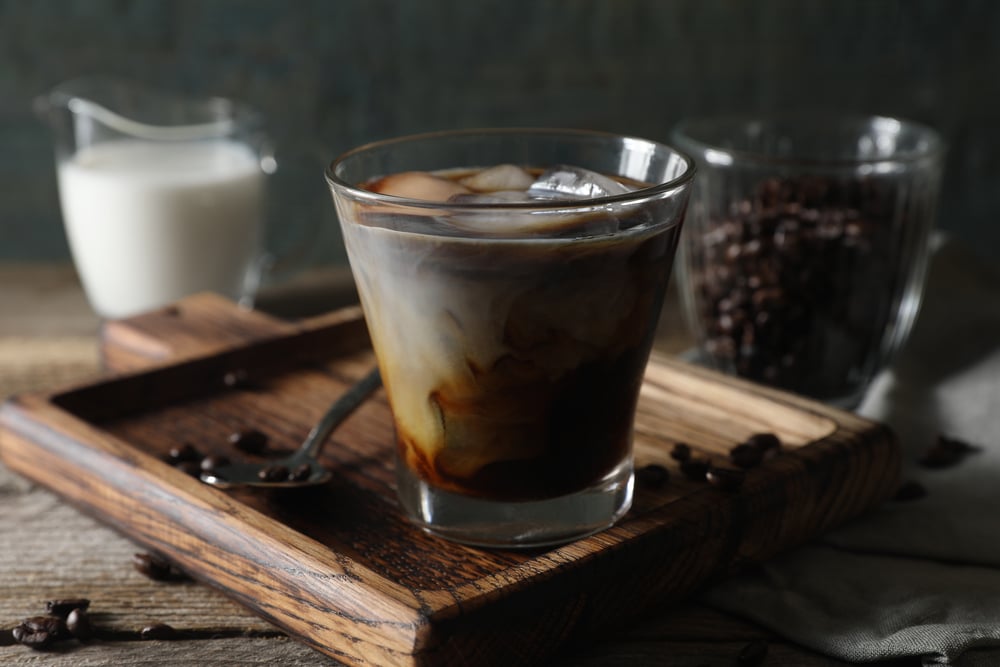What Is Cold Brew Coffee?

In the world of coffee, one brewing method has been making waves for its distinct flavor and refreshing appeal – cold brew coffee. Cold brew provides an invigorating and customizable departure from traditional hot coffee, boasting a unique brewing process that yields a smooth and less acidic taste. Its appeal extends to various preferences – whether over ice, with milk, or as a versatile base for creative cocktails. Cold brew’s enduring popularity continues to captivate coffee lovers around the globe.
What Is A Cold Brew?
Cold brew coffee is a method of brewing coffee that uses cold or room temperature water over an extended period, typically 12 to 24 hours. Unlike traditional hot brewing methods like drip coffee, cold brew doesn’t involve heat during the extraction process. Instead, it relies on time to slowly extract the flavors from coarsely ground coffee beans.
One key characteristic of cold brew is its smooth and less acidic taste, making it an appealing option for those who find traditional coffee too bitter. The slow extraction process also brings out different flavor profiles, often highlighting the coffee’s natural sweetness.
What Is Special About Cold Brew Coffee?
Brewing with cold water delays the extraction of coffee flavors, changing which chemicals are drawn out, oxidized, degraded, lost, or retained in the grounds. This process results in a distinct flavor shift. Unlike hot-brewed coffee, cold brew taste less acidic and bitter because certain acids don’t extract, and others avoid oxidation. Additionally, many aromatic oils, often lost in the intense heat of traditional hot brewing, are preserved in cold brew. The result is a cup that is flavorful, smooth, refreshing, and less bitter.
What Does Cold Brew Taste Like?
Cold brewed coffee is renowned for its smooth, mellow, and less acidic taste compared to traditional hot-brewed coffee. It often features mild acidity, enhanced natural sweetness, and a full-bodied, robust flavor profile without bitterness. Depending on the coffee beans used, you might detect chocolatey or nutty undertones.
Caffeine Content in Cold Brew
Keep in mind that when you make cold brew you typically make a concentrate that is meant for dilution prior to consumption. This involves using a higher coffee-to-water ratio, resulting in a coffee concentrate that can have significantly more caffeine than the same volume of hot brewed coffee.
The extended steeping time further enhances caffeine extraction. It’s estimated that there’s about 200 mg of caffeine per 16 ounces, this can vary based on factors like the type of beans, the coffee-to-water ratio, water temperature, grind size, and brewing time.
But when preparing cold brew for final consumption, the concentrate is diluted with ice, water, milk, cream, or sweeteners, effectively lowering the overall caffeine concentration to amounts similar to a standard cup of hot coffee.
Cold Brew Vs. Iced Coffee Vs. Iced Americano
While cold brew, iced coffee, and iced Americano may all seem similar, they differ significantly in terms of preparation and taste. Iced coffee is traditionally brewed with hot water, usually in a drip coffee maker, and then cooled down with ice. This method tends to retain the acidity and bitterness associated with hot coffee, albeit in a chilled form.
An iced Americano is made by pulling and espresso shot and then diluting it with water. Ice is then added to chill it. Iced Americanos offer a bold and robust flavor with noticeable acidity.
On the other hand, cold brew is brewed with cold water from the start, resulting in a smoother and less acidic profile. The extended steeping time gives cold brew a unique depth of flavor that sets it apart from iced coffee.
Cold Brew Vs. Hot Coffee
The primary distinction between cold brew and hot coffee lies in the brewing method and temperature. Hot coffee is made by steeping coffee grounds in hot water, typically between 195°F to 205°F (90°C to 96°C), for a much shorter period – usually a few minutes.
The hot water extracts flavors quickly, including the acidic and bitter compounds, which can be prominent in traditional coffee. Cold brew, in contrast, relies on cold or room temperature water and a much longer extraction time, resulting in a mellower and less acidic taste.
Cold Brew vs. Cold Brew Concentrate
Cold brew concentrate is a more potent version of regular cold brew. It is achieved by using a higher ratio of coffee grounds to water during the brewing process. This concentrated form is later diluted with water, milk, or a milk alternative before consumption.
The advantage of cold brew concentrate is its versatility. Users can control the strength of their coffee by adjusting the dilution ratio according to personal preferences. It also allows for creative coffee-based recipes, such as coffee cocktails or desserts, where a concentrated coffee flavor is desired.
What Kind Of Coffee Should I Use for Cold Brew?

When it comes to making cold brew, the type of coffee you choose can significantly impact the flavor profile of the final brew. Here are some key considerations for selecting the right coffee for your cold brew:
- Quality Matters: Start with high-quality coffee beans. Cold brew has a longer brewing time, so using fresh and flavorful beans will enhance the overall taste. Experiment with different varieties to find the flavor profile you enjoy the most.
- Freshly Ground Coffee Beans: The act of grinding coffee just before brewing preserves the delicate oils and aromatic compounds that contribute to the intricate flavor profile of the beans. This process ensures a more nuanced and rich taste in the final cold brew, enhancing the overall freshness and quality of the beverage.
- Coarse Grounds: Opt for coarsely ground coffee beans. The coarse grind is essential for the extended steeping process in cold water, allowing for a smoother extraction without over-extracting bitter compounds.
- Medium to Dark Roast: While the choice between medium and dark roast is subjective, many cold brew enthusiasts lean towards medium to dark roasts. These roasts tend to impart a rich and bold flavor that complements the cold brewing method.
- Avoid Flavored Coffee: While flavored coffees can be delightful, it’s advisable to stick to plain, non-flavored coffee beans for cold brew. The slow extraction process may not complement certain artificial or added flavors. If you want added flavor you can add flavored syrups to your cold brew before consumption.
- Experiment: Don’t hesitate to experiment with different coffee varieties and brands. Cold brew is versatile, and your choice of coffee can greatly influence the nuances of the final beverage. Try a few options to discover your preferred cold brew flavor profile.
Remember that the ideal coffee for cold brew is one that aligns with your taste preferences. Whether you enjoy a bright and fruity brew or a bold and chocolatey one, the key is to choose coffee that enhances the characteristics you love in a cold, refreshing format.
Cold Brew Ratios
The coffee-to-water ratio plays a crucial role in shaping the strength and flavor of your cold brew. For a cold brew concentrate, a common ratio is 1:4, indicating one part coffee to four parts water. If you prefer a ready-to-drink cold brew, a ratio of 1:8 to 1:12 is recommended. However, feel free to experiment with different ratios to find the perfect balance for your taste.
To achieve a stronger brew, consider increasing the amount of coffee grounds or reducing the water ratio. Conversely, for a milder flavor, adjust the ratio in favor of more water. The beauty of this cold coffee beverage lies in its adaptability, allowing you to tailor the brewing process to suit your personal taste.

How to Make Cold Brew Coffee Concentrate
Making cold brew coffee at home is a simple process that requires minimal equipment. Here’s a basic guide to crafting your own cold brew:
- Coarsely Grind Coffee Beans: Use high-quality, coarsely ground coffee beans. A coarse grind helps in achieving a smoother extraction.
- Combine Coffee and Water: In a container, mix the coarsely ground coffee with cold or room temperature water. The general ratio is around 1:4 or 1:5 coffee to water. (If you want a ready-to-drink cold brew use a ratio of 1:8 to 1:12)
- Steep for 12-24 Hours: Allow the coffee mixture to steep in the refrigerator for an extended period. The longer the steeping time, the stronger the cold brew.
- Strain the Coffee: After steeping, strain the coffee to remove the grounds. This can be done using a fine-mesh sieve, cheesecloth, or a purpose-built cold brew coffee maker.
- Dilute and Serve: Dilute the cold brew concentrate with water, milk, or a milk alternative, depending on your preference. Serve over ice and enjoy.
Remember to Dilute Cold Brew Concentrate
When dealing with cold brew concentrate, it’s important to remember that it is meant to be diluted before consumption. The concentrate is highly potent and can be overpowering if not mixed with water or milk. Experiment with different dilution ratios to find the strength that suits your taste preferences.
How to Drink Cold Brew
Cold brew is incredibly versatile and can be enjoyed in various ways. Here are some popular ways to savor your cold brew:
- Dilute Concentrate: For an optimal cold brew, aim for a concentrate-to-water ratio ranging from 2:1 to 1:1. If a stronger brew is your preference, stick to the 2:1 ratio. For a milder option, lean towards the 1:1 ratio.
- Over Ice: The classic way to enjoy cold brew is over ice. This method enhances the refreshing qualities of the beverage.
- With Milk or Cream: Add your choice of milk or cream to create a creamier texture and flavor.
- Sweetened or Flavored: Customize your cold brew with sweeteners like sugar or flavored syrups for a personalized touch.
- In Coffee Cocktails: Use cold brew as a base for coffee cocktails. Mix it with spirits like vodka or whiskey for a delightful beverage.

Storing Cold Brew Concentrate
Storing cold brew concentrate is convenient for those who want to prepare larger batches and enjoy coffee on-demand. Keep the concentrate in a sealed container in the refrigerator. It can last for up to two weeks, maintaining its flavor and freshness.
Frequently Asked Questions
Is Cold Brew Stronger Than Regular Coffee?
There’s a widespread misconception about cold brew having high caffeine content, but this is not entirely accurate. When preparing cold brew, a concentrate is typically made using a higher coffee-to-water ratio and an extended steeping time, facilitating more caffeine extraction. However, it’s important to understand that the concentrate is intended for dilution. Therefore, when you have the final cold brew product ready for consumption, the overall caffeine content per serving is comparable to that of a standard cup of hot coffee.
Can You Use Regular Ground Coffee for Cold Brew?
While coarser grounds are optimal for the best outcomes, regular ground coffee is still suitable for cold brew. It’s crucial to recognize that using regular ground coffee may yield a hazier brew with increased sediment compared to a coarser grind. This is due to the larger surface area of finer grounds, leading to the release of more oils and fine particles into the water.
If opting for regular ground coffee in cold brew, it is advised to employ a fine filter or cheesecloth during straining to remove any sediment before consumption. You will also need to make adjustments to the brewing time and the coffee-to-water ratio. Due to the finer particles, the extraction process is quicker; prolonged steeping can result in over-extraction, leading to bitterness.
Can I Make Cold Brew with a French Press?
Yes, you can absolutely make cold brew with a French press. In fact, a French press can be a convenient and effective tool for crafting delicious cold brew coffee.
Mary is a writer at Caffe Streets. She works in the healthcare field and finds pleasure in learning, researching, and sharing coffee-related information with coffee enthusiasts worldwide. Her coffee of choice is the affogato, a beverage/dessert she deems simply perfection.





